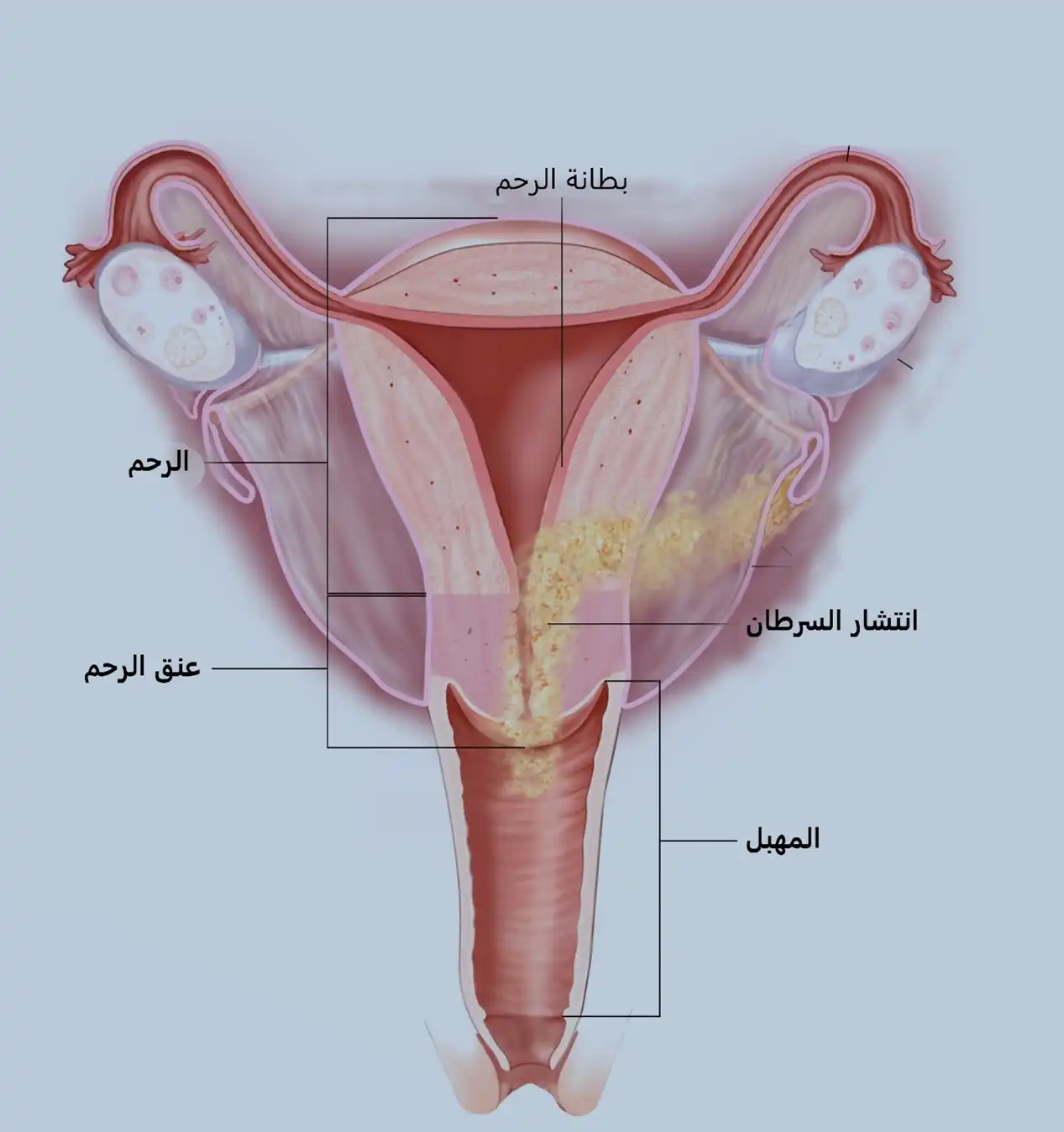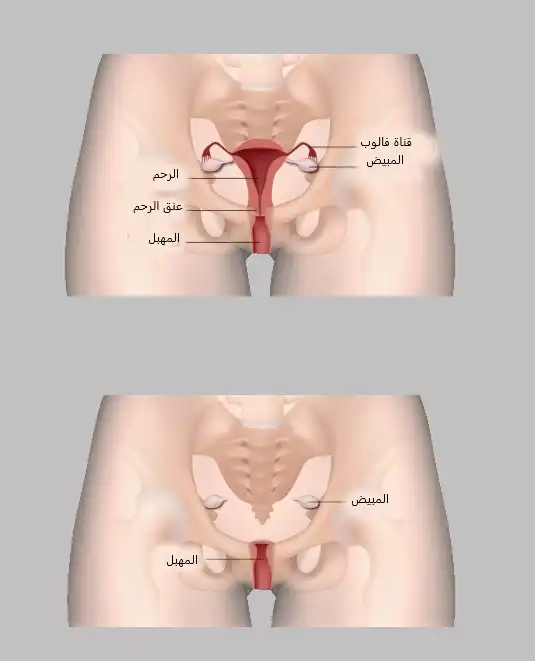سرطان عنق الرحم أعراضه وأسبابه وطرق الوقاية وأفضل المراكز لعلاجه في تركيا على يد أفضل الأطباء الجراحة النسائية والتوليد في اسطنبول.
سرطان عنق الرحم من السرطان القليلة ذات المسبب المحدد مما يزيد من إمكانية الوقاية منه ،يعد إجراء الفحوصات المنتظمة لأمراض النساء وإجراء اختبارات لعنق الرحم من أهم الخطوات التي يمكن للمرأة اتخاذها للوقاية من سرطان عنق الرحم، حيث يمكن تفادي الكثير من الاختلاطات في حال اتبعنا ما سيذكر لاحقاً في المقال.
وفقاً لمنظمة الصحة العالمية يعد سرطان العنق الرحمي السرطان الرابع الأكثر شيوعاً بين النساء، وفي عام 2022، شُخصَّ ما يقدر بنحو 000 570 حالة إصابة في كافة أنحاء العالم.
ما هو سرطان عنق الرحم؟
يحدث سرطان عنق الرحم نتيجة تكاثر شاذ لخلايا عنق الرحم. هناك نوعان رئيسيان من سرطان عنق الرحم: سرطان الخلايا الحرشفية والسرطانة الغدّية.
تشكل سرطانات الخلايا الحرشفية حوالي 80٪ إلى 90٪ من الحالات، بينما تكون 10٪ إلى 20٪ منها سرطانات غدية Adenocarcinoma.
لمحة عامة عن عنق الرحم
عنق الرحم cervix هو الجزء السفلي من اﻟﺮﺣﻢ، حيث يتكون الرحم من جزأين الجزء العلوي حيث ينمو الطفل ويدعى جسم الرحم والجزء السفلي وهو الذي يدعى عنق الرحم.
لعنق الرحم وظائف عدة ومنها أنه يربط جسم الرحم بالمهبل (قناة الولادة) حيث يشكل معبر لمرور النطاف لجسم الرحم، كما يشكل ممر لمرور الجنين عند الولادة.
ومن وظائفه الأخرى أنه يفرز مخاطاً يساعد على ترطيب الجهاز التناسلي الأنثوي.

اسباب سرطان عنق الرحم وعوامل خطورته
يعد الفيروس الحليمي البشري HPV ببعض أنواعه سبباً لسرطان عنق الرحم وهو من السرطانات القليلة معروفة السبب، إضافة لذلك يوجد العديد من عوامل الخطورة للإصابة به، وتتضمن بعض عوامل الخطر ما يلي:
- الفحص النسائي غير المنتظم: النساء اللواتي لم يقمن بإجراء اختبار عنق الرحم (اللطاخة) بشكل منتظم ودوري معرضات بشكل متزايد لخطر الإصابة بسرطان عنق الرحم.
- عدوى فيروس الورم الحليمي البشري HPV: تنتقل بعض أنواع فيروس الورم الحليمي البشري عن طريق الاتصال الجنسي ويمكن أن تصيب عنق الرحم، عدوى عنق الرحم بفيروس الورم الحليمي البشري هي عامل الخطر والمسبب الأساسي لسرطان عنق الرحم. ومع ذلك، فإن نسبة صغيرة جداً من النساء المصابات بفيروس الورم الحليمي البشري غير المعالج يصبن بهذا السرطان.
- التاريخ الجنسي: إن تعدد الشركاء الجنسين لدى المرأة يجعلها أكثر عرضة للإصابة بفيروس الورم الحليمي البشري وسرطان عنق الرحم، كما أن الوقاية من الأمراض المنقولة جنسياً تقلل من خطر الإصابة بسرطان العنق الرحمي.
- التدخين: يرتبط تدخين السجائر بزيادة خطر الإصابة بأي سرطان بشكل عام.
- عدوى فيروس نقص المناعة البشرية HIV: النساء المصابات بفيروس نقص المناعة البشرية لديهن مخاطر أعلى من المتوسط للإصابة بهذا النوع من السرطان.
يمكنك أن تقرأ على موقعنا أيضاً عن سرطان الثدي وأحدث تقنيات العلاج له في تركيا.

اعراض سرطان عنق الرحم
لا تظهر بالمراحل المبكرة من سرطان العنق الرحمي أي ألم أو أعراض أخرى، ولمعرفة أفضل حول الأعراض وما يمكن أن يظهر لدى المريضة عند الإصابة بسرطان العنق الرحمي سنقسم أعراض سرطان عنق الرحم إلى أعراض مبكرة ومتأخرة.
أعراض سرطان عنق الرحم المبكرة
من المحتمل أن تشمل الأعراض الأولى التي يمكن أن تشير للمرض ما يلي:
- إفرازات مهبلية مائية أو دموية قد تكون سميكة وقد يكون لها رائحة كريهة.
- نزيف مهبلي بعد الجماع أو ممارسة الرياضة، بين فترات الحيض، أو بعد سن اليأس.
- فترات الحيض أغزر وتستمر لفترة أطول من المعتاد.
اعراض سرطان عنق الرحم المتأخرة
إذا انتشر السرطان إلى الأنسجة القريبة، فقد تشمل الأعراض ما يلي:
- التبول الصعب أو المؤلم، مع وجود دم في البول أحياناً.
- إسهال أو ألم أو نزيف من المستقيم عند التغوط.
- التعب وفقدان الوزن والشهية.
- آلام في الظهر أو تورم في الساقين.
إذا استمر النزيف غير الطبيعي، أو الإفرازات المهبلية، أو أي أعراض أخرى لأكثر من أسبوعين دون تفسير، فيجب إجراء فحص نسائي كامل يتضمن مسحة عنق الرحم.
كيف يتم تشخيص سرطان عنق الرحم؟
يمكن لفحوصات الحوض ومسحات عنق الرحم أن تساعد في الكشف المبكر عن معظم حالات سرطان العنق الرحمي.
للحصول على تشخيص دقيق، يقوم الطبيب بفحص عنق الرحم بصرياً ويأخذ عينة من الأنسجة لدراسة أي شذوذ واضح للتوجه لإجراء خزعة تُشخّص السرطان بهذه الحالة.
إذا أكدت الخزعة وجود السرطان، يتم اللجوء الى المزيد من الاختبارات لمعرفة ما إذا كان السرطان قد انتشر، قد تشمل هذه الاختبارات دراسات وظائف الكبد والكلى، وتحاليل الدم والبول، وأخذ صور الأشعة السينية للمثانة والمستقيم والأمعاء.
أقرأ أكثر عن طرق تشخيص وعلاج السرطان في تركيا.
مراحل سرطان عنق الرحم
- المرحلة الأولى: السرطان موجود فقط في عنق الرحم.
- المرحلة الثانية: انتشر السرطان خارج عنق الرحم ولكنه لم ينتشر بعد إلى جدار الحوض.
- المرحلة الثالثة: انتشر السرطان إلى الثلث السفلي من المهبل أو انتشر إلى جدار الحوض والغدد الليمفاوية المجاورة.
- المرحلة الرابعة: يصيب السرطان في هذه المرحلة المثانة أو المستقيم أو أجزاء أخرى من الجسم.

هل الفحوصات النسائية الروتينية ضرورية؟
لا يوجد إجماع في الأوساط الطبية حول ما إذا كانت المرأة بحاجة إلى فحص الحوض في السنوات التي ليس عليها فيها فحص سرطان عنق الرحم.
تترك بعض الجمعيات الطبية الأمر للطبيب لتقرير ما إذا كان ينبغي إجراء فحص الحوض، لكن بعض الجمعيات الطبية الأخرى لا تشجع على القيام بفحص الحوض بسبب ما يسببه من ازعاج للمريض.
لسوء الحظ، لم يثبت فحص الحوض أبداً أنه يقي من السرطانات، خاصة بالنسبة للسرطانات التي تقلق النساء أكثر من غيرها، مثل سرطان المبيض.
تُنصح الشابات بعمر ال 25 عاماً أو أقل واللواتي يمارسن نشاطاً جنسياً بإجراء اختبار فحص سنوي للكشف عن الكلاميديا.
علاج سرطان عنق الرحم
يعتمد علاج سرطان العنق الرحمي على العديد من العوامل بما في ذلك مرحلة السرطان، وعمر المريضة، والصحة العامة للمرأة، ورغبتها في الإنجاب في المستقبل.
العلاجات الثلاثة الرئيسية لسرطان عنق الرحم هي العلاج الإشعاعي والعلاج الكيميائي والجراحة.
يمكن استخدام العلاج الإشعاعي أو الكيميائي لعلاج السرطان المنتشر خارج الحوض (المرحلة الرابعة) أو السرطان الناكس.
العلاج الإشعاعي
هناك طريقتان للعلاج الإشعاعي:
- إما يتم وضع جهاز محمل بحبيبات مشعة في المهبل بالقرب من السرطان ويتم تثبيته في مكانه لفترة زمنية معينة.
- أو يتم تعريض المناطق المستهدفة إلى الإشعاع على مدى جلسات متعددة لدى أخصائي العلاج الإشعاعي.
العلاج الكيميائي
هنالك مجموعة متنوعة من أدوية العلاج الكيميائي يتم استخدامها. وفي بعض الأحيان التي يتم اللجوء فيها إلى الجراحة يستخدم العلاج الإشعاعي والكيميائي قبل الجراحة أو بعدها.
يمكن القراءة أكثر حول العلاج الكيميائي للسرطان في تركيا.
العلاج الجراحي
تُستخدم أنواع مختلفة من التقنيات الجراحية لعلاج سرطان عنق الرحم، إليك بعض العلاجات الجراحية لسرطان عنق الرحم الأكثر شيوعًا:
- الجراحة بالليزر: تستخدم هذه الجراحة شعاع الليزر لحرق الخلايا أو لأخذ قطعة صغيرة من الأنسجة للدراسة.
- الخزعة مخروطية: وهي عملية جراحية يتم فيها إزالة قطعة نسيج مخروطية الشكل من عنق الرحم.
- استئصال الرحم البسيط: تتضمن هذه الجراحة إزالة الرحم وليس الأنسجة المجاورة للرحم. لا يتم إزالة المهبل أو العقد اللمفاوية الموجودة في الحوض.
- الاستئصال الجذري للرحم والعقد الليمفاوية في الحوض: في هذه الجراحة، يتم إزالة الرحم والأنسجة المحيطة به وقسم صغير من الجزء العلوي من المهبل والعقد اللمفاوية من الحوض.

قد يكون السرطان في مراحله الأولى قابلاً للشفاء عن طريق إزالة الأنسجة السرطانية. أما في الحالات المتقدمة، فيتم اللجوء إلى إجراء استئصال بسيط أو جذري للرحم.
أحدث طرق علاج سرطان الرحم المطبقة مأخراً في تركيا
تعد هذه العلاجات إما علاجات مساعدة للعلاجات السابقة أو أنها تستخدم في حالات خاصة أو كملاذ أخير في حال فشل العلاجات الأخرى.
خزعة العقدة اللمفية الحارسة Sentinel Lymph Node Biopsy
يمكن أن تستخدم هذه الطريقة في أي نوع كان من السرطان، وآليتها أنه يجرى خزعة أو استئصال (أثناء العمل الجراحي) للعقد اللمفية الذي يشك أنها ستصاب قبل العقد اللمفية الأخرى، وفي حال لم يجد الأطباء علامة لوجود السرطان في هذه العقد (أو العقدة)، فلا داعي لاستئصال باقي العقد اللمفية المجاورة.
لهذا الإجراء فائدة كبيرة حيث يمنع الاختلاطات الناجمة عن الاستئصال الواسع للعقد اللمفية وخاصة الوذمات في الساقين
العلاج المناعي
ما زالت الدراسات قائمة حول مدى نجاعة هذا العلاج في علاج سرطان العنق الرحمي.
إن العلاج المناعي هو علاج يساعد مناعة الجسم على التصدي للتكاثر العشوائي والسريع للخلايا السرطانية.
وإن غالب الدراسات تقوم على Immune Checkpoint Inhibitors.
العلاج الموجه
إن العلاج الموجه طريقة علاجية متقدمة غير متوفرة في جميع البلدان وهي ذات تكلفة عالية.
بيفاسيزوماب هو دواء موجه يستخدم حالياً لعلاج سرطان العنق الرحمي المتقدم، كما أثبتت الأدوية المستهدفة الأخرى، مثل Cediranib (يمنع بعض عوامل النمو التي تساعد الخلايا السرطانية على النمو) على أنها مفيدة.
لقاح سرطان عنق الرحم
لقاح سرطان عنق الرحم المسمى Gardasil®، معتمد للفتيات والنساء اللواتي تتراوح أعمارهن بين 9 و26 عاماً ويقي من الإصابة بسرطان عنق الرحم.
هذا اللقاح، يحمي أيضاً من الثآليل التناسلية (وقد تمت الموافقة عليه للذكور أيضا لهذا الغرض) يعمل هذا اللقاح عن طريق تحفيز جهاز المناعة في الجسم لمهاجمة أنواع معينة من فيروس الورم الحليمي البشري (HPV)، والتي تم ربطها بالعديد من حالات سرطان عنق الرحم.
من الأفضل أخذ التطعيم قبل بدء النشاط الجنسي، يتكون التطعيم من سلسلة من 3 جرعات، الجرعة الثانية تأتي بعد شهرين من الأولى، والجرعة الثالثة تأتي بعد ستة أشهر من الجرعة الأولى.
هل يمكن الوقاية من سرطان عنق الرحم؟
يمكن للمرأة اتخاذ بعض التدابير للوقاية من سرطان عنق الرحم.
يعد إجراء الفحوصات النسائية منتظمة بشكل دوري من أهم الخطوات التي يمكن للمرأة اتخاذها للوقاية من سرطان عنق الرحم.
توصي الجمعية الأمريكية لأطباء النساء والتوليد بإرشادات التالية لفحص عنق الرحم الدوري:
- يجب أن تبدأ جميع النساء في فحص لطخات دورية من عنق الرحم عندما يبلغن من العمر 21 عاماً، كما يجب تكرار الفحص كل 3 سنوات.
قد تكون هناك حاجة لمزيد من الفحوص إذا تم العثور على أي خلايا غير طبيعية أو إذا كان فيروس الورم الحليمي البشري موجوداً. - ابتداءً من سن ال30، النساء اللواتي حصلن على 3 نتائج طبيعية لاختبار عنق الرحم على التوالي يمكن أن يخضعن للفحص كل 5 سنوات مع اختبار مسحة عنق الرحم واختبار عدوى فيروس الورم الحليمي البشري من النوع عالي الخطورة، هناك خيار آخر مقبول وهو أن يتم الفحص كل 3 سنوات باختبار مسحة عنق الرحم فقط.
- أما النساء اللواتي لديهن عوامل خطر معينة مثل التعرض للديثيلستيلبيسترول (DES) قبل الولادة، أو عدوى فيروس نقص المناعة البشرية، أو ضعف جهاز المناعة بسبب زرع الأعضاء أو العلاج الكيميائي أو استخدام الستيرويد المزمن، فيجب أن يخضعن للفحص سنوياً.
- على النساء اللواتي تتراوح أعمارهن بين 65 و70 عاماً أو أكثر ممن خضعن لثلاثة مسحات عنق رحم سلبية (طبيعي) متتالية ولا توجد نتائج غير طبيعية لاختبار عنق الرحم في العشرين عاماً الماضية التوقف عن إجراء فحص سرطان عنق الرحم. يجب أن تستمر النساء اللواتي لديهن سوابق من الإصابة بسرطان عنق الرحم أو التعرض لـDES قبل الولادة أو عدوى فيروس نقص المناعة البشرية أو ضعف جهاز المناعة في إجراء الفحص طالما أنهن يتمتعن بصحة جيدة.
- يجب على النساء اللواتي خضعن لعملية استئصال الرحم الكامل (إزالة الرحم وعنق الرحم) التوقف أيضاً عن إجراء فحص سرطان عنق الرحم، ما لم يكن لديهن تاريخ من الإصابة أو احتمال الإصابة بسرطان العنق الرحمي.
يجب على النساء اللواتي خضعن لعملية استئصال الرحم دون إزالة عنق الرحم الاستمرار في اتباع الإرشادات المذكورة أعلاه.
بالنهاية نجد أن سرطان العنق الرحمي أحد أهم السرطانات التي تصيب الجهاز التناسلي الأنثوي وعلاجه وتشخيصه بشكل باكر من أهم الأمور لتضمن المرأة حياة صحية سواء على الصعيد الجنسي أو الإنجابي أو النفسي، كما ينصح مركز بيمارستان النساء بإجراء فحوصات دورية والحفاظ على نظام صحي يومي لتجنب الإصابة بأي سرطان كان.
المصادر:
